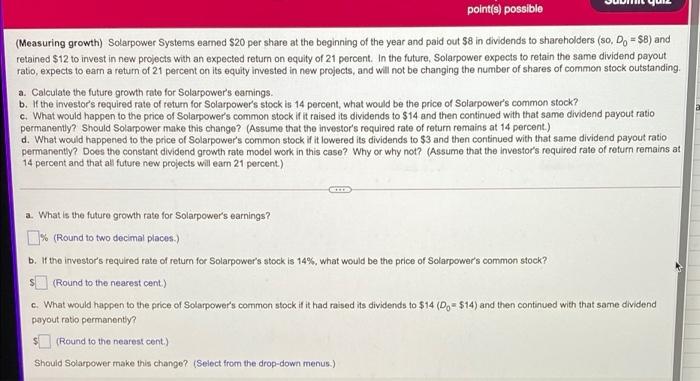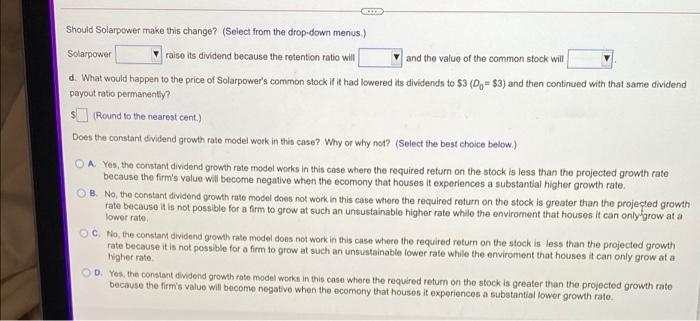point(s)possible (Measuring growth) Solarpower Systems earned S20 per share at the beginning of the year and paid out $8 in dividends to shareholders (so, Do - $8) and retained $12 to invest in new projects with an expected return on equity of 21 percent. In the future, Solarpower expects to retain the same dividend payout ratio, expects to earn a return of 21 percent on its equity invested in new projects, and will not be changing the number of shares of common stock outstanding, a. Calculate the future growth rate for Solarpower's camings. b. If the investor's required rate of return for Solarpower's stock is 14 percent, what would be the price of Solarpower's common stock? c. What would happen to the price of Solarpower's common stock if it raised its dividends to $14 and then continued with that same dividend payout ratio permanently? Should Solarpower make this change? (Assume that the investor's required rate of return remains at 14 percent.) d. What would happened to the price of Solarpower's common stock if it lowered its dividends to $3 and then continued with that same dividend payout ratio permanently? Does the constant dividend growth rate model work in this caso? Why or why not? (Assume that the investor's required rate of return remains at 14 percent and that all future new projects will earn 21 percent) a. What is the future growth rate for Solarpower's earnings? % (Round to two decimal places.) b. If the investor's required rate of return for Solarpower's stock is 14%, what would be the price of Solarpower's common stock? (Round to the nearest cent) c. What would happen to the price of Solarpower's common stock if it had raised its dividends to $14 (D = $14) and then continued with that same dividend payout ratio permanently? (Round to the nearest cent.) Should Solarpower make this change? (Select from the drop-down menus.) Should Solarpower make this change? (Select from the drop-down menus.) Solarpower raise its dividend because the retention ratio will and the value of the common stock will d. What would happen to the price of Solarpower's common stock if it had lowered its dividends to $3 (0 - $3) and then continued with that same dividend payout ratio permanently? (Round to the nearest cent) Does the constant dividend growth rate model work in this case? Why or why not? (Select the best choice below.) OA. Yes, the constant dividend growth rate model works in this case where the required return on the stock is less than the projected growth rate because the firm's value will become negative when the ecomony that houses it experiences a substantial higher growth rate. OB. No, the constant dividend growth rate model does not work in this case where the required return on the stock is greater than the projeted growth rate because it is not possible for a firm to grow at such an unsustainable higher rate while the enviroment that houses it can only grow at a lower rato OC No, the constant dividend growth rate model does not work in this case where the required return on the stock is less than the projected growth rate because it is not possible for a firm to grow at such an unsustainable lower rate while the enviroment that houses it can only grow at a higher rate OD. Yes, the constant dividend growth rate model works in this case where the required return on the stock is greater than the projected growth rate because the firm's value will become negative when the ecomony that houses it experiences a substantial lower growth rato








